by Craig Brelsford
Founder, shanghaibirding.com
WHAT THIS REPORT IS ABOUT
In this report, you will get an introduction to Boli County and eastern Heilongjiang, you will discover the birds we met there at the height of the breeding season, you will learn about the birds we missed, and you will find out how Elaine Du and I combine birding with family. There are as well my sound-recordings of Boli birds and plenty of photos.
WHY SHOULD BIRDERS CARE ABOUT BOLI?
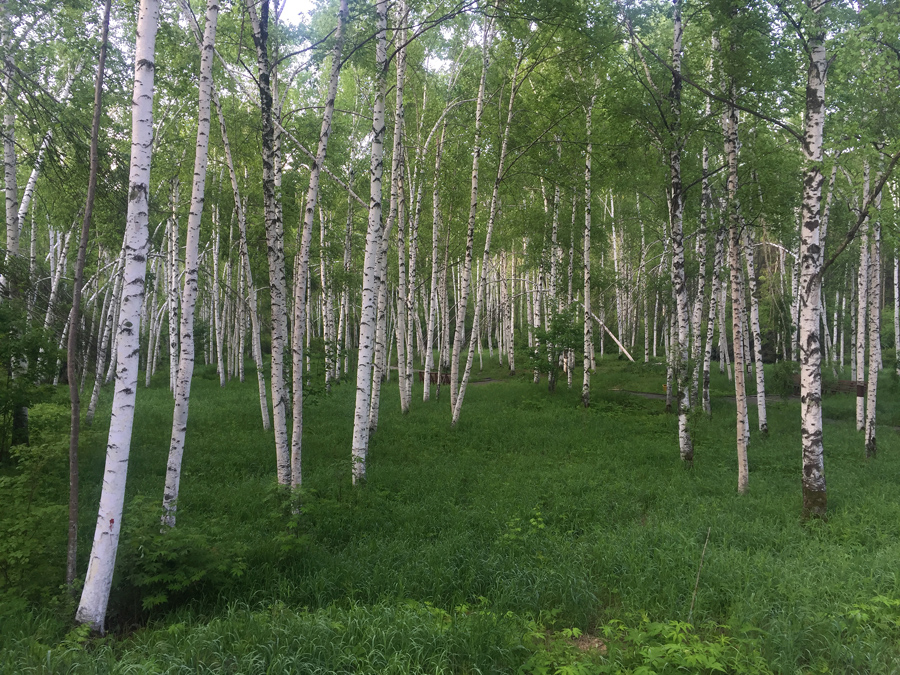
Boli County is a good place to study the woodland birds of the eastern Palearctic. Its forests, remnants of the ancient northern temperate forest that once stretched unbroken across the region, hold northern species absent further south in China. In springtime, Boli County is the breeding home of birds that in the more densely populated southern regions of China appear only as passage migrants or winter visitors.
INTRODUCTION
From 26 May to 12 June 2016, Elaine Du and I visited her home village of Dawucun (Dàwǔcūn [大五村], 45.732679, 130.589612) in Boli County, Heilongjiang, China. We birded 15 of those days, mainly around Xidaquan National Forest (Xīdàquān Guójiā Sēnlín Gōngyuán [西大圈国家森林公园], 45.727751, 130.317316). We noted 84 species. Our bird of the trip was Band-bellied Crake, and we found breeding Eurasian Eagle-Owl. We noted in full breeding mode many birds that we had previously known only as passage migrants in Shanghai; we heard for the first time the songs of Siberian Blue Robin, Blue-and-white Flycatcher, White-throated Rock Thrush, Siberian Thrush, and many other species.
BACKGROUND

In January 2015 Elaine and I were married in Dawucun, where Elaine was born. During breaks in the festivities, I explored the frozen country. Expecting to find only magpies and sparrows, I was pleasantly surprised to find forested hills near the village and good birds such as Rough-legged Buzzard. I vowed to return and bird the area thoroughly.
In August and September 2015, Elaine and I fulfilled that goal. During a 32-day visit to her hometown, Elaine and I discovered Xidaquan National Forest, a reserve in the Laoye Mountains covering 9,400 hectares (36 sq. mi.). Xidaquan preserves a remnant of the northern temperate forest that once covered the region. We were thoroughly impressed and made plans to bird the area yet again, this time during breeding season. The trip described here is the realization of that plan.
For Elaine and me, birding trips to Boli are special because they combine Northeast China birding with family. Elaine is never happier than when she is with her parents and two elder sisters, and I not only like her family but also appreciate the opportunity they give me to learn about Chinese culture.

Like many residents of the Northeast, Elaine is descended from migrants who chuǎng Guāndōng (闯关东)—“leapt” north, mainly from Hebei and Shandong, to farm areas of Guandong (Manchuria) formerly closed to Han Chinese settlement. In Elaine’s case, the settlers were her parents, who left Shandong in the 1970s.
The settlement of the Northeast by Han farmers is a major event in Chinese history, like the settling of the West is to Americans. The transformation the migration has wrought on the land has been profound. In eastern Heilongjiang, the toil of thousands of farmers has converted the land from an endless forest into a vast maize field. Where tigers once roared, magpies now caw.
Amid the sea of grain fields are islands of the old Manchurian forest. One of the best is Xidaquan National Forest, just 25 km (15.5 mi.) from Boli Town. After our discovery of Xidaquan in the summer of 2015, we turned it into our laboratory in which to study the birds of the eastern Palearctic woodlands. We have now spent 20 days birding in the reserve—12 days in summer 2015 and eight days in spring 2016.
For more information on places mentioned in the text, see “List of Place Names” in Part 2.
KEY BIRDS
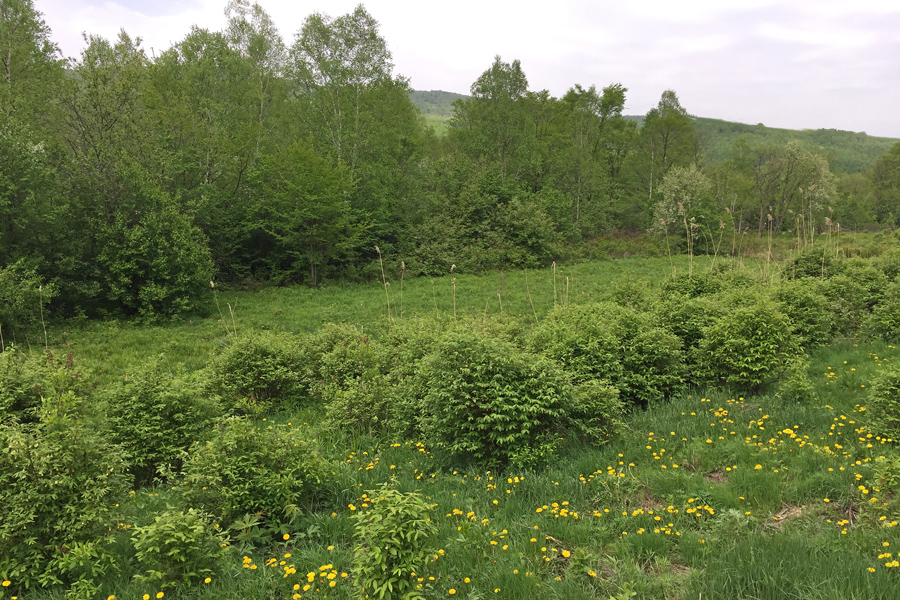
A birder led blindfolded through Boli County in spring would be able to tell the quality of the forest by the birds he heard. The pine plantations are nearly silent. In recently cut areas where the forest has just begun to regenerate, one may hear a few Eastern Crowned Warbler, Radde’s Warbler, and Black-faced Bunting. If a layer of undergrowth has formed, then one may hear in addition to those species Thick-billed Warbler, Siberian Blue Robin, and Siberian Rubythroat. In places where most of the trees are hardwoods and have reached a height of about 10 m (33 ft.), the sound of birdsong is constant throughout the day. Pale Thrush sing powerfully from perches hidden in the canopy, Yellow-throated Bunting sing from treetops and defend territory, Willow Tit, Coal Tit, and Japanese Tit sing their lively Parid songs, and White-throated Rock Thrush whistle in a minor key. The best places at Xidaquan are yet another cut above, being able to support the aforementioned species as well as more habitat-sensitive birds such as Mandarin Duck, Rufous Hawk-Cuckoo, Lanceolated Warbler, Gray’s Grasshopper Warbler, and White’s Thrush.
The following is a list of the key birds noted by Craig Brelsford and Elaine Du in spring 2016 in Boli County, Heilongjiang. Hyperlinks on the names of species connect to entries in my Photographic Field Guide to the Birds of China, published in its entirety on this website.
• Band-bellied Crake Zapornia paykullii
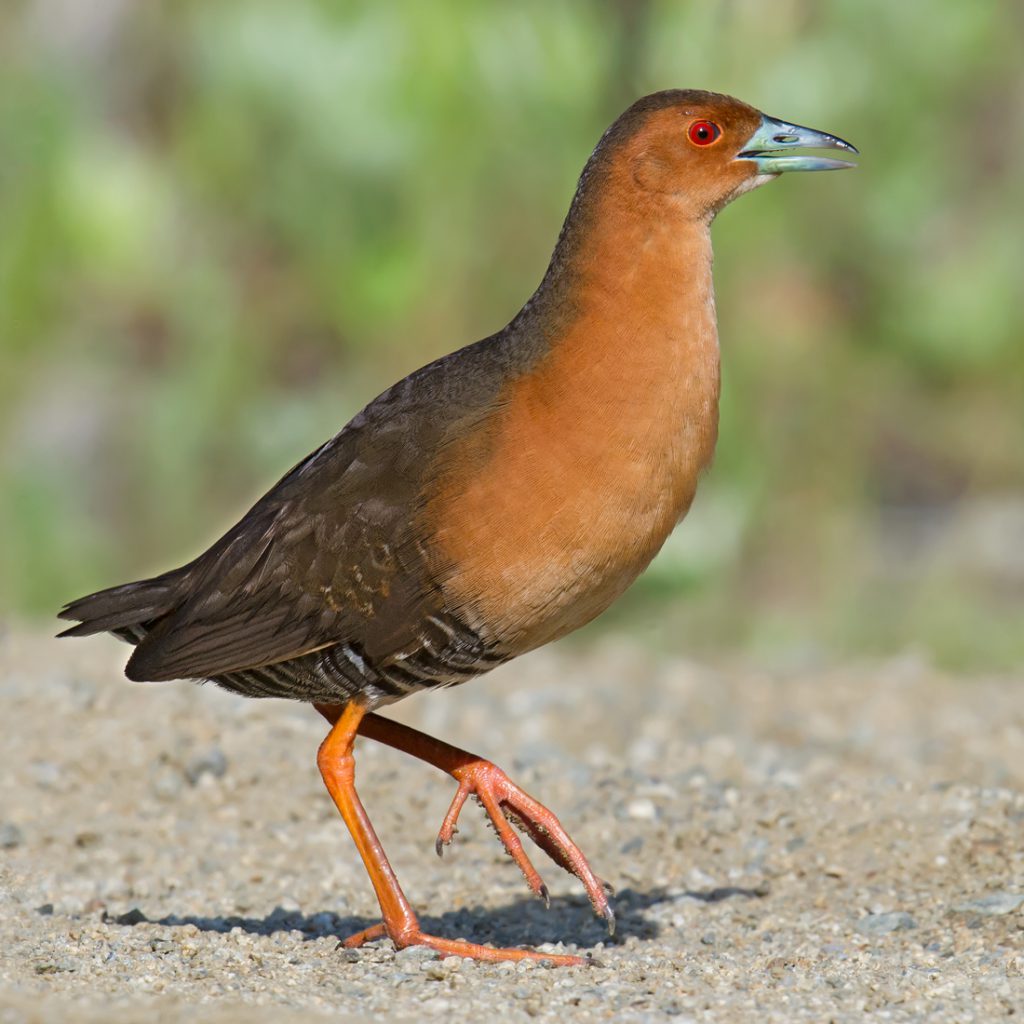
Our bird of the trip, found 8–9 June in a creek bottom (45.637215, 130.548444) in the Hongwei Linchang area 12 km (7.5 mi.) south of Boli Town. A rare and little-known species, Band-bellied Crake is listed as near-threatened by the IUCN. Band-bellied Crake breeds in Northeast China and the Russian Far East. It is threatened by habitat loss in its Southeast Asia wintering grounds as well as in Northeast China.
Band-bellied Crake Zapornia paykullii, creek bottom (45.637215, 130.548444) near Hongwei Linchang, 12 km (7.5 mi.) south of Boli, elev. 450 m (1,480 ft.), 9 June, by Craig Brelsford (0:25, 2.6 MB)
• Eurasian Eagle-Owl Bubo bubo
We found a breeding pair with two owlets nesting at the high, inaccessible reaches of the big quarry at Jiulong Reservoir, where we also spotted the species in summer 2015. The giant owls are tolerant of the traffic from the road, and at a second, smaller quarry nearby, they tolerate noise from a busy poultry farm below. The owls perch conspicuously by day and are active in the villages at night. In summer 2015, eagle-owls would perch at night on the buildings of Elaine’s parents’ farm.
• Mandarin Duck Aix galericulata
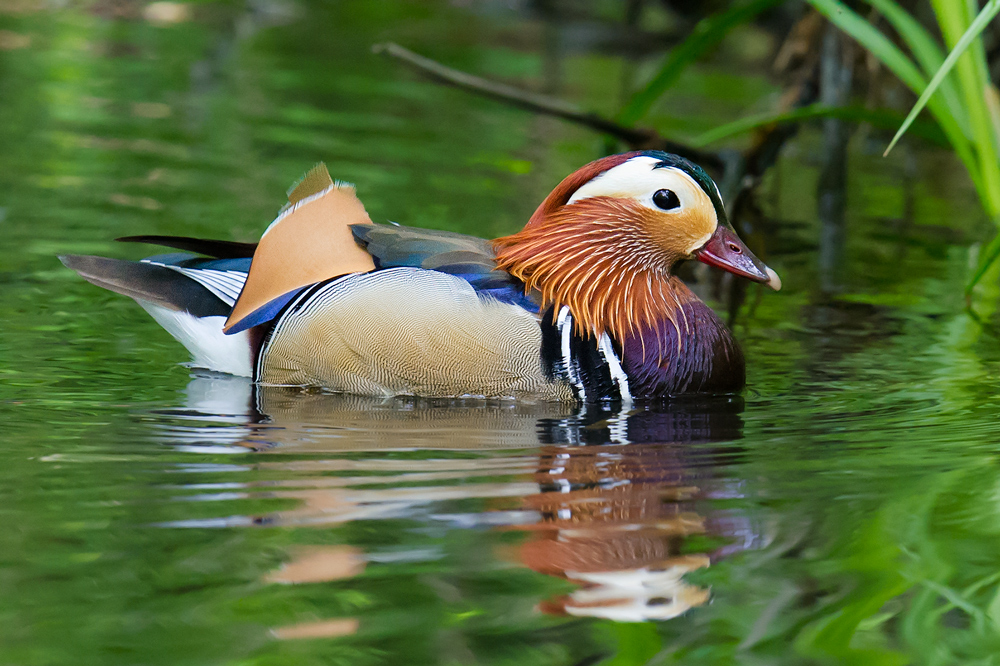
Deep in the forests of Xidaquan, we found Mandarin Duck in ponds no larger than a kiddie pool. This shy species was also found on the large pond near the entrance to Xidaquan, in rice paddies in the villages, and in flocks in Jiulong Reservoir. In spring 2016 we recorded this species on eight of our 15 birding days and in summer 2015 on seven of our 27 birding days. Boli County is the heart of the Northeast China breeding range of this most beautiful of ducks.
• Black Woodpecker Dryocopus martius
A graceful woodpecker and one of the stars of the Northeast Chinese forest, noted by us on three days in spring 2016 and on 11 days in summer 2015.
• White-backed Woodpecker Dendrocopos leucotos leucotos
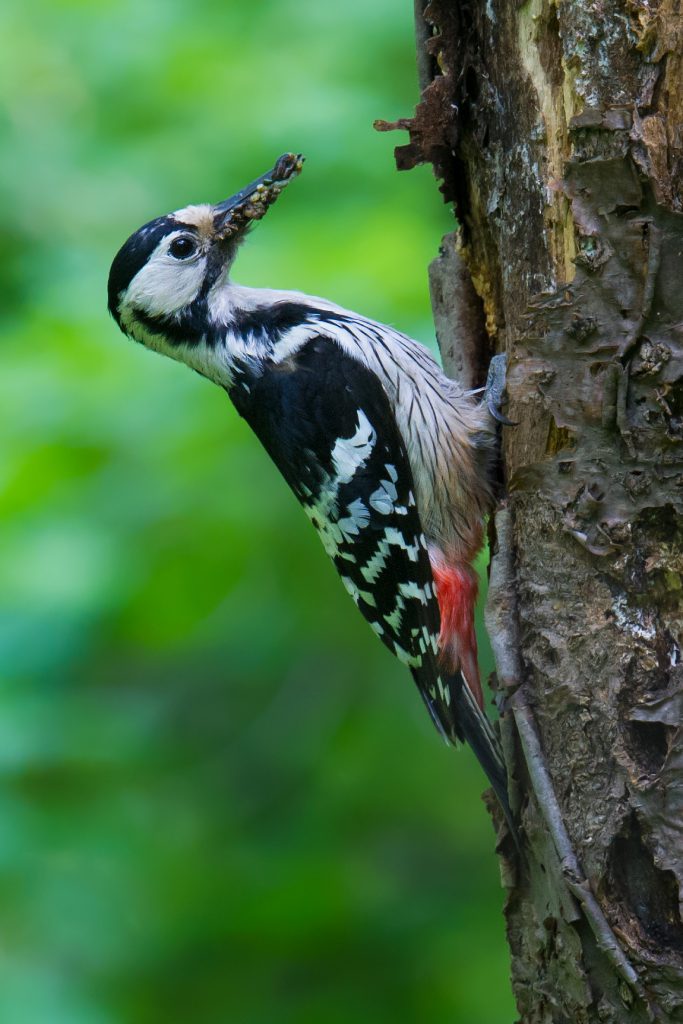
The most commonly noted Dendrocopos woodpecker, noted on 10 days in summer 2015 and six days in spring 2016.
• Lesser Spotted Woodpecker Dryobates minor
Trans-Eurasian species, in China present only in Xinjiang and the Northeast. Noted by us just once in spring 2016. More conspicuous in summer 2015 (seen on six days) and winter 2015 (three days).
• Rufous Hawk-Cuckoo Hierococcyx hyperythrus
Noted on nine of our birding days, exclusively in the better forests around Xidaquan. Has softer version of the “Brain fever!” call of Large Hawk-Cuckoo.
Rufous Hawk-Cuckoo Hierococcyx hyperythrus, song, Xidaquan National Forest (45.709510, 130.372510), elev. 680 m (2,230 ft.), 2 June, by Craig Brelsford (1:06; 3 MB)
• Indian Cuckoo Cuculus micropterus
Noted on eight days in Boli County in spring 2016. None of our records came from the higher-quality, higher-elevation forest deep in Xidaquan park but from the lower-quality, newer forests closer to the villages.
Indian Cuckoo Cuculus micropterus, classic four-note call, Boli, 9 June, by Craig Brelsford (0:02; 880 KB)
• Oriental Cuckoo Cuculus optatus
In contrast to Indian Cuckoo, in spring 2016 most of our records of Oriental Cuckoo, spanning 13 days, came from the deep forests of Xidaquan.
Oriental Cuckoo Cuculus optatus, classic double note boop boop, Xidaquan National Forest (45.720702, 130.280567), elev. 610 m (2,000 ft.), 30 May, by Craig Brelsford (0:03; 600 KB)
• Common Cuckoo Cuculus canorus
We heard the famous call of Common Cuckoo on 13 days. Most records came from open areas or from forested places near open areas.
• Grey Nightjar Caprimulgus jotaka
We enjoyed pre-dawn views of this species roosting on County Road Z002 and heard its clattering song both at dawn and dusk.
Grey Nightjar Caprimulgus jotaka jotaka, singing at dawn, Blue-and-white Flycatcher in background, Boli (45.709510, 130.372510), elev. 680 m (2,230 ft.), 2 June, by Craig Brelsford (0:30; 2 MB)
Grey Nightjar C. j. jotaka, two singing at dawn, White’s Thrush singing ventriloquially in background, Boli (45.709510, 130.372510), elev. 680 m (2,230 ft.), 2 June, by Craig Brelsford (1:21; 14 MB)
• Eurasian Jay Garrulus glandarius brandtii
Cinnamon-headed ssp. brandtii is a treat for birders in Northeast China (also occurs in Xinjiang). Resident and conspicuous in all seasons.
• Coal Tit Periparus ater ater
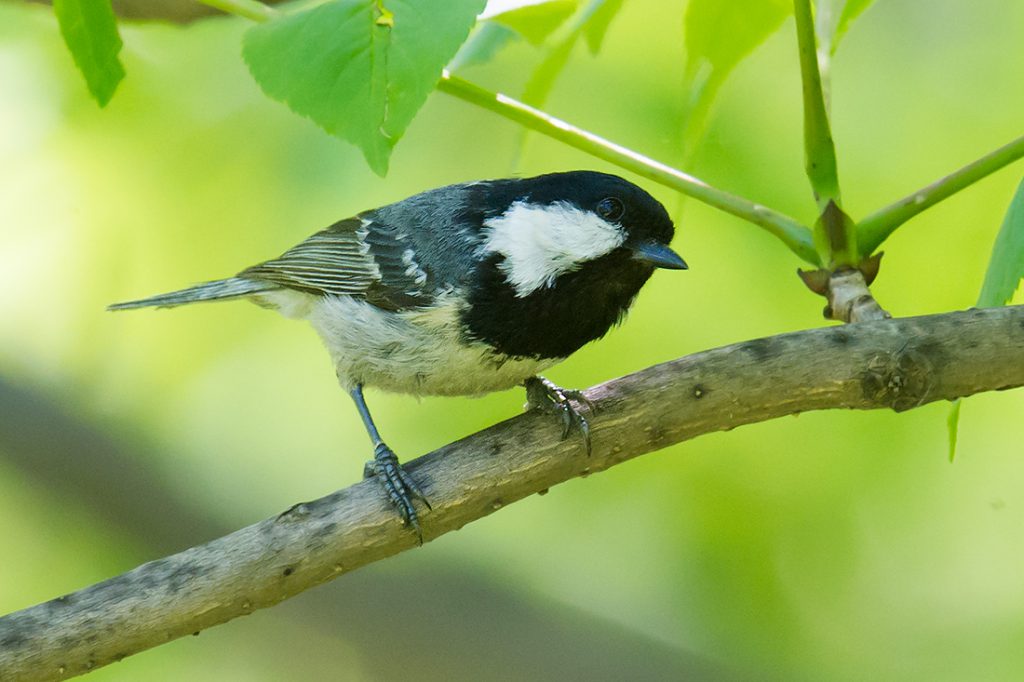
The trans-Eurasian, small-crested, nominate race (ater) is the representative of Coal Tit in Northeast China. Resident, regularly noted in small numbers, often in conifers.
Coal Tit Periparus ater ater, song, hills (45.666389, 130.583631) south of Boli, Heilongjiang, elev. 450 m (1,460 ft.), 7 June, by Craig Brelsford (0:15; 2.2 MB)
Coal Tit P. a. ater, song, hills (45.666389, 130.583631) south of Boli, Heilongjiang, elev. 450 m (1,460 ft.), 7 June, by Craig Brelsford (0:04; 1.7 MB)
• Willow Tit Poecile montanus baicalensis
Versatile Willow Tit, resident in Boli County, flourishes in habitats ranging from scrubby new forest growth to primary forest. Noted on three days in winter 2015, 21 in summer 2015, and 11 in spring 2016.
Willow Tit Poecile montanus baicalensis, territorial call, hills (45.666389, 130.583631) south of Boli, Heilongjiang, elev. 450 m (1,460 ft.), 7 June, by Craig Brelsford (0:14; 2.1 MB)
• Long-tailed Tit Aegithalos caudatus caudatus
The snowball-headed nominate ssp. ranges from Scandinavia east through Heilongjiang to Jilin. It lives year-round in Boli County. We noted it on seven days in spring 2016, on two days in winter 2015, and on 14 days in summer 2015. In late summer and winter it is often the main component of bird waves.
• Eastern Crowned Warbler Phylloscopus coronatus
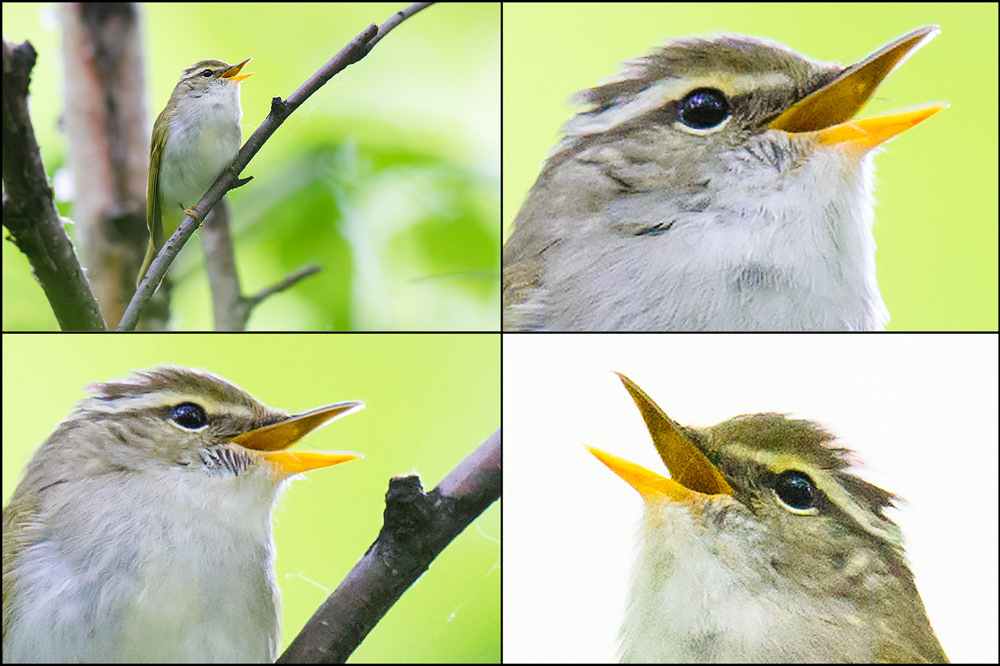
The most conspicuous leaf warbler in Boli. Noted by us on 10 days in summer 2015 and on 14 of our 15 birding days in spring 2016. Sings a diverse array of songs from dawn to dusk. In 2015 was singing and defending territory into mid-August, and non-singing individuals were noted as late as 3 Sept. Found in habitats mediocre as well as pristine.
Eastern Crowned Warbler Phylloscopus coronatus, song, hills south of Dawucun (45.704930, 130.578132), Heilongjiang, elev. 400 m (1,310 ft.), 5 June, by Craig Brelsford (0:04; 757 KB)
Eastern Crowned Warbler P. coronatus, song, Xidaquan National Forest (45.688678, 130.313736), Heilongjiang, elev. 500 m (1,650 ft.), 29 May, by Craig Brelsford (0:39; 7 MB)
• Radde’s Warbler Phylloscopus schwarzi
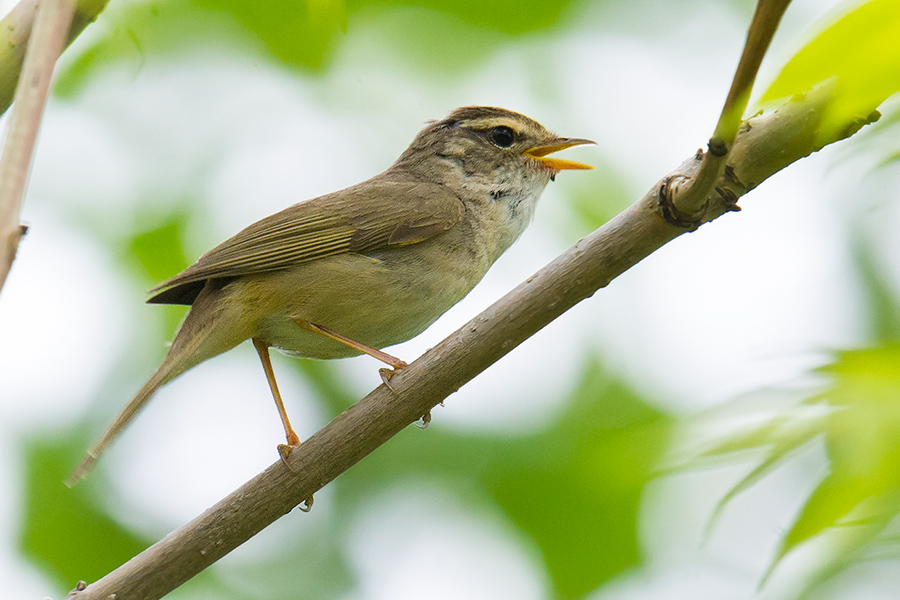
Second only to Eastern Crowned Warbler as the most conspicuous leaf warbler, with a powerful song that belies its small size. Noted regularly in summer 2015 (10 days) and spring 2016 (12 days), mostly in the better forest and forest-edge habitat at Xidaquan.
Radde’s Warbler Phylloscopus schwarzi, song, Xidaquan National Forest (45.720702, 130.280567), Heilongjiang, elev. 610 m (2,000 ft.), 30 May, by Craig Brelsford (2:51; 29 MB)
• Dusky Warbler Phylloscopus fuscatus
Noted on 10 days in spring 2016 and nine in summer 2015. Has less powerful song than Radde’s, lacking trills, and unlike Radde’s avoids deep forest. Often sings from conspicuous perch in high tree.
• Pale-legged Leaf Warbler Phylloscopus tenellipes
Recorded on nine days in spring 2016. Heard singing and seen defending territory. Usually found in the high canopy or middle canopy in the better sections of forest at Xidaquan. Elaine and I did not note this species in Boli in summer 2015.
Pale-legged Leaf Warbler Phylloscopus tenellipes, song, Xidaquan National Forest (45.720702, 130.280567), Heilongjiang, elev. 610 m (2,000 ft.), 10 June, by Craig Brelsford (1:59, 20 MB)
• Pallas’s Leaf Warbler Phylloscopus proregulus
Noted on nine days in spring 2016 and on 12 days in summer 2015. In both seasons was usually noted singing loudly from the top of the tallest tree in the vicinity.
Pallas’s Leaf Warbler Phylloscopus proregulus, hills S of Dawucun, 4 June (1:47; 18 MB)
• Oriental Reed Warbler Acrocephalus orientalis
Oriental Reed Warbler is known to be able to use marshy habitat with woody plants rather than reeds. As reeds are rare in the areas we bird in Boli County, our Oriental Reed Warbler were found among woody plants. Found on four days in spring 2016, mainly on the shore of Jiulong Reservoir.
Oriental Reed Warbler, Jiulong Reservoir, 10 June (0:06; 1.8 MB)
• Black-browed Reed Warbler Acrocephalus bistrigiceps
Noted on three days in spring 2016, with a high of 28 singing individuals being found 11 June along County Road Z002. Noted once in summer 2015.
Black-browed Reed Warbler, creek along County Road Z002, 11 June (1:40; 4.8 MB)
• Thick-billed Warbler Arundinax aedon
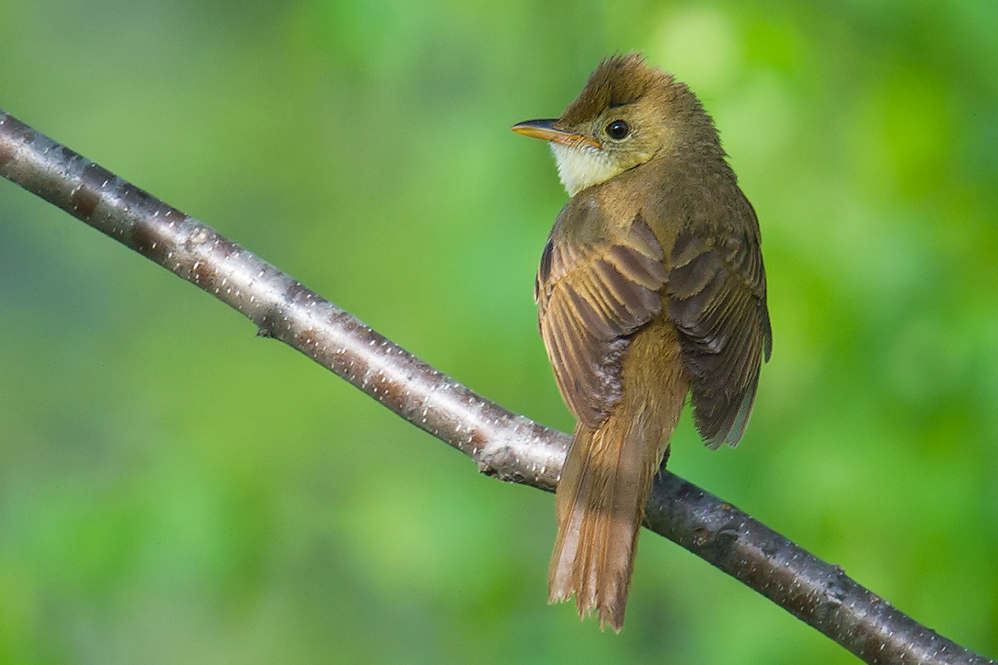
Noted on six days in spring 2016, in very good habitat at Xidaquan as well as more disturbed areas along the shore of Jiulong Reservoir.
Thick-billed Warbler, Xidaquan, 29 May (0:32; 2.1 MB)
• Lanceolated Warbler Locustella lanceolata
Noted on six days in spring 2016, singing from thick cover in heavily wooded habitat along creeks at Xidaquan.
• Gray’s Grasshopper Warbler Helopsaltes fasciolatus
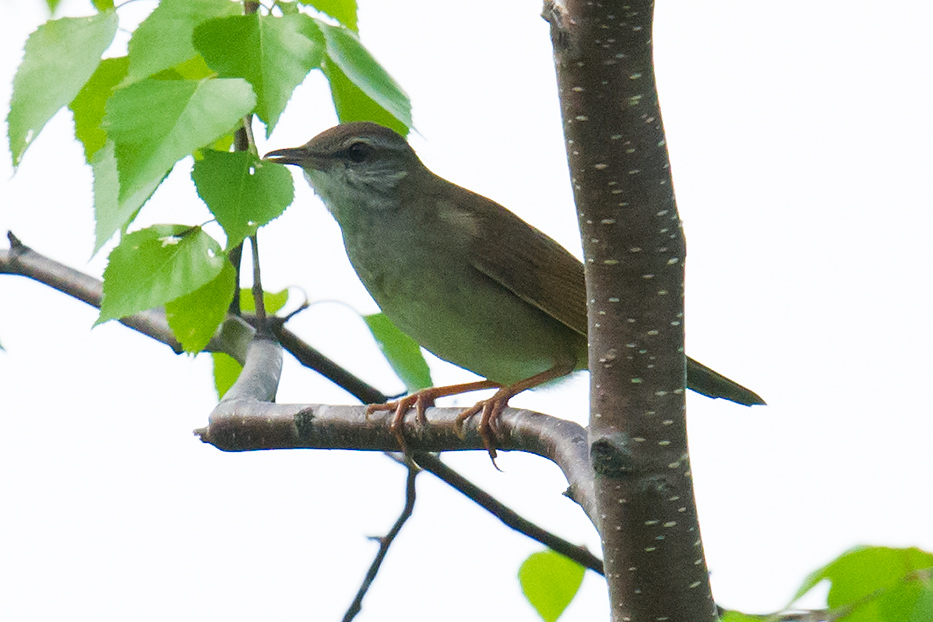
In spring 2016 we heard the bulbul-like call of this undergrowth skulker on seven days, exclusively in the high-quality habitat at Xidaquan.
Gray’s Grasshopper Warbler, Xidaquan, 2 June (1:05; 3.4 MB)
• Siberian Thrush Geokichla sibirica
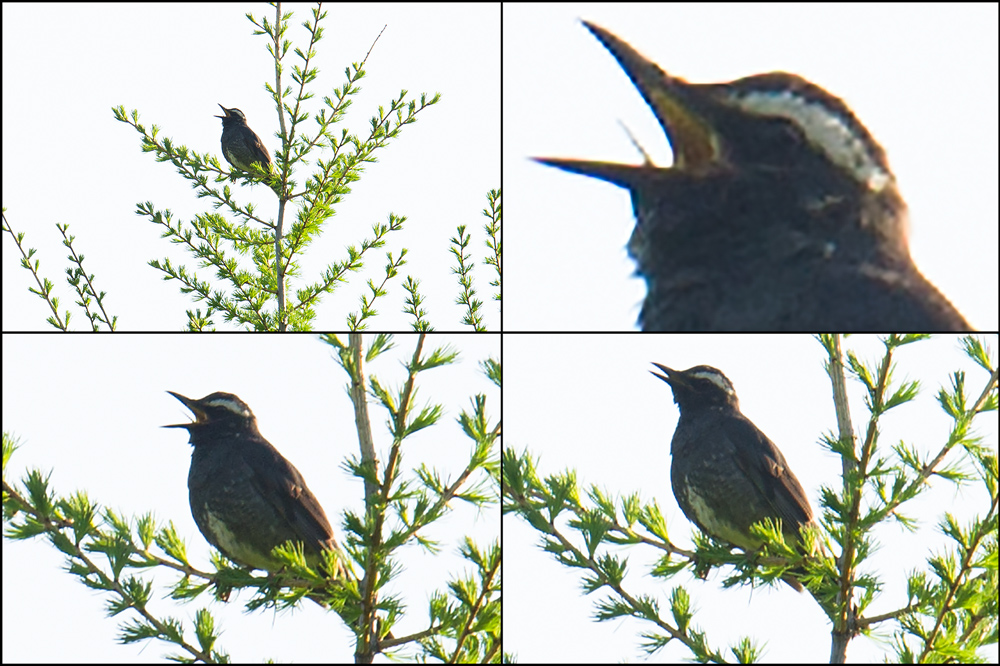
Noted by us on five days in spring 2016, each time in high-quality forest at Xidaquan. Noted twice in summer 2015. Sings from conspicuous perch at top of tall tree.
Below is a recording of Siberian Thrush on a typical morning at Xidaquan. In the background you can hear Oriental Cuckoo, Common Cuckoo, Radde’s Warbler, Eastern Crowned Warbler, and Gray’s Grasshopper Warbler.
Siberian Thrush, Xidaquan, 3 June (0:51; 2.8 MB)
• White’s Thrush Zoothera aurea
One of the rewards for waking early was hearing the monotonous, ventriloquial song of White’s Thrush. It normally calls unseen from deep within the forest and goes silent about an hour after sunrise. One morning Elaine and I saw this most secretive bird climb a tall tree and utter its mysterious call. The first, lower note was apparently hummed through its closed or barely open mouth, while for the high note the thrush gaped wide. At a location nearby I witnessed the ventriloquy. The low note seemed to be coming from a place to my right, while the high note seemed to be coming from a place in front of me. Only after a few minutes did I realize that a single unseen White’s Thrush was uttering both notes.
White’s Thrush, Xidaquan, 2 June (1:43; 4.9 MB)
• Grey-backed Thrush Turdus hortulorum
This East Asian endemic was noted on nine days in spring 2016, singing and defending territory. Also noted on two days in summer 2015.
Grey-backed Thrush, hills S of Boli Town, 7 June (08:17; 21.4 MB)
• Pale Thrush Turdus pallidus
Noted on eight days in spring 2016 and five days in summer 2015. Shy. Sings powerfully from unseen perches deep in the forest. At dawn and dusk sometimes seen foraging on the roadside.
Pale Thrush Turdus pallidus, song, Xidaquan National Forest (45.727751, 130.317316), elev. 600 m (1,970 ft.), June, by Craig Brelsford (1:25; 5 MB)
• Blue-and-white Flycatcher Cyanoptila cyanomelana
We found Mark Brazil’s description of the breeding habitat to be apt: “ … in forested mountains, generally in mature mixed broadleaf forest with dense undergrowth, often near streams … ” (Birds of East Asia). Noted on eight days in spring 2016 and on two days in summer 2015.
Blue-and-white Flycatcher, broadleaf forest near Xidaquan, 27 May (1:30; 4.4 MB)
• Siberian Blue Robin Larvivora cyane
Noted on 12 days in spring 2016, with a high of 21 individuals on 2 June. Its song, delivered from deep cover, consists of a burst of sound followed by a pause and buildup then another burst, each burst distinct from the other.
Siberian Blue Robin Larvivora cyane, Xidaquan National Forest (45.727751, 130.317316), elev. 500 m (1,640 ft.), 2 June, by Craig Brelsford (2:41; 7.2 MB)
• Rufous-tailed Robin Larvivora sibilans
Noted on seven days in spring 2016, all records except one coming from deep cover along thickly vegetated creeks at Xidaquan. Song a descending trill.
Rufous-tailed Robin, Xidaquan, 28 May (1:01; 3.2 MB)
• Siberian Rubythroat Calliope calliope
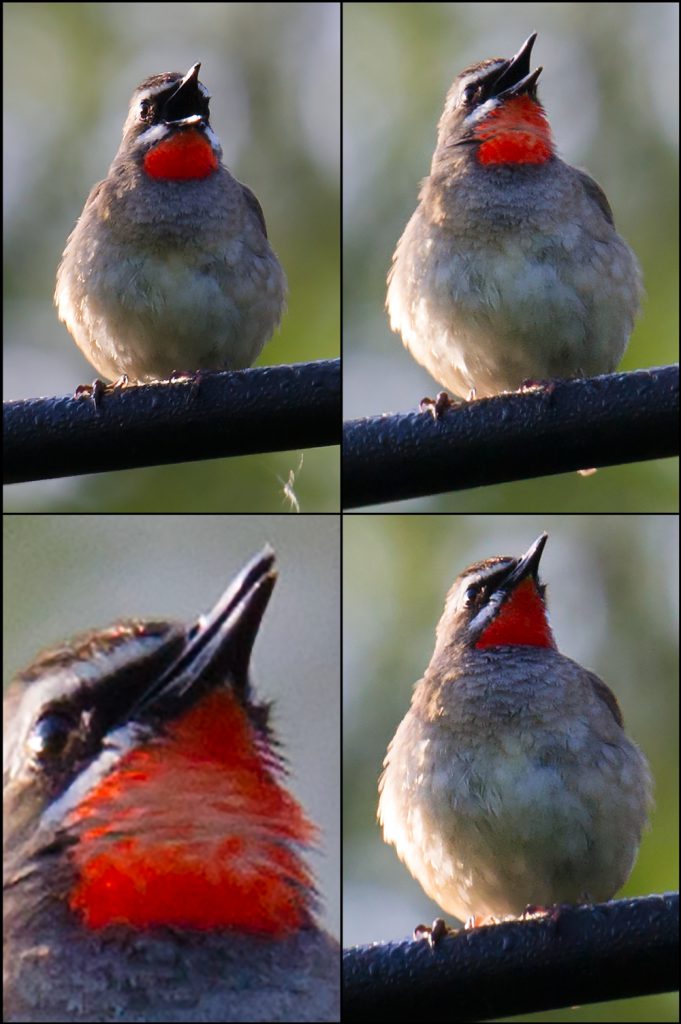
Noted on four days in spring 2016 and on one day in summer 2015. Usually hides in undergrowth, but at dawn and for a few hours thereafter may be seen singing from an exposed perch.
Siberian Rubythroat, Xidaquan, 28 May (2:20; 6.4 MB)
• Yellow-rumped Flycatcher Ficedula zanthopygia
Sings a long, slow, deliberate, and loud song somewhat like that of Blue-and-white Flycatcher. Noted on 12 days in spring 2016.
Yellow-rumped Flycatcher, hills S of Dawucun, 5 June (0:58; 3.1 MB)
• White-throated Rock Thrush Monticola gularis
I learned the call of this East Asian specialty by doggedly following a bird that was singing and moving unseen in the canopy above me. Finally the secretive singer allowed me to glimpse him, and only then could I confirm that he was White-throated Rock Thrush. Noted on three days in spring 2016 and once in summer 2015.
White-throated Rock Thrush, Hongwei Linchang, 7 June (1:04; 4.1 MB)
• Siberian Long-tailed Rosefinch Carpodacus sibiricus
Noted on eight days in spring 2016 and four days each in winter and summer 2015.
• Meadow Bunting Emberiza cioides weigoldi
Resident, recorded by us in winter, summer, and spring (five days in spring 2016). Seen at edges of farmland and in open areas near forests. Never in deep forests.
• Meadow Bunting, forest edge at Dawucun, 31 May (0:58; 3.1 MB)
• Tristram’s Bunting Emberiza tristrami
Forest bunting, with some association with conifers, commonly seen along the forest roads. Noted on eight days in spring 2016 and six days in summer 2015.
Tristram’s Bunting, Xidaquan, 3 June (0:11; 1.2 MB)
• Yellow-throated Bunting Emberiza elegans
Forest bunting with a preference for deciduous habitats. Sings loudly and aggressively defends territory. Noted on nine days in spring 2016 and on 16 days in summer 2015.
Yellow-throated Bunting 1/2, song, hills S of Boli Town, 5 June (0:12; 1.3 MB)
Yellow-throated Bunting 2/2, alarm call, hills S of Dawucun, 7 June (0:50; 3.6 MB)
• Black-faced Bunting Emberiza spodocephala spodocephala
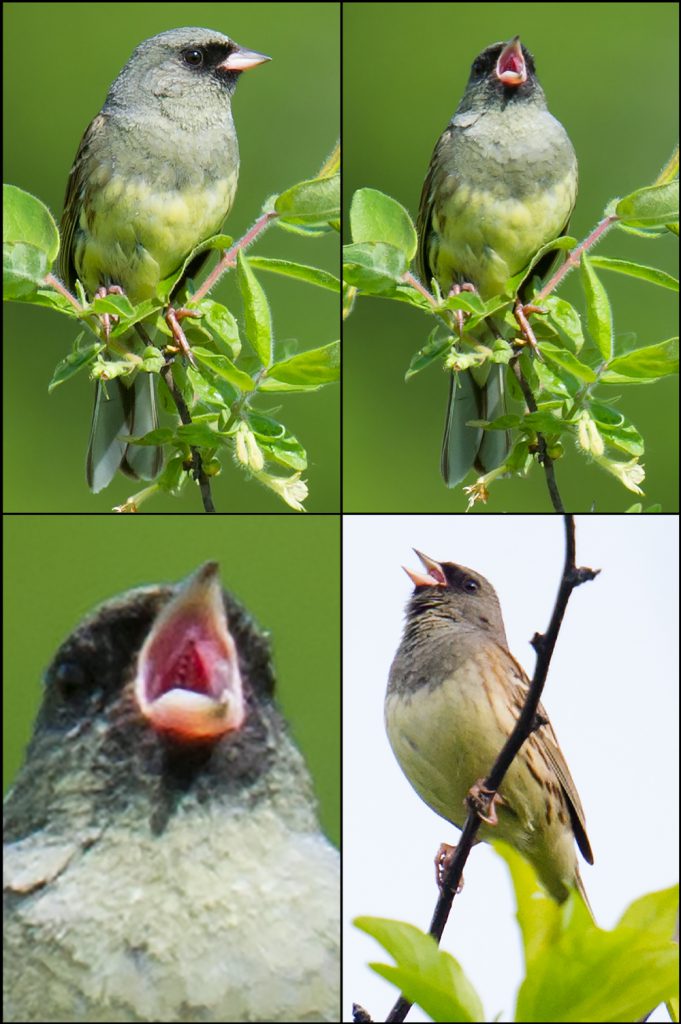
One of the most commonly noted birds in Boli, found on 14 days in spring 2016 and 12 days in summer 2015. Versatile, often at forest edge but also in areas with fewer trees.
Black-faced Bunting, Xidaquan, 30 May (0:44; 2.5 MB)
SPECIES OF BIRD NOTED BY CRAIG BRELSFORD AND ELAINE DU IN BOLI COUNTY, HEILONGJIANG, CHINA, MAY–JUNE 2016 (84 SPECIES)
Hyperlinks connect to entries in Craig Brelsford’s Photographic Field Guide to the Birds of China, published in its entirety on this website:
Mandarin Duck Aix galericulata
Mallard Anas platyrhynchos
Eastern Spot-billed Duck Anas zonorhyncha
Common Pheasant Phasianus colchicus
Little Grebe Tachybaptus ruficollis
Great Crested Grebe Podiceps cristatus
Oriental Honey Buzzard Pernis ptilorhynchus orientalis
Northern Goshawk Accipiter gentilis
Eastern Buzzard Buteo japonicus
Band-bellied Crake Zapornia paykullii
Little Ringed Plover Charadrius dubius
Common Sandpiper Actitis hypoleucos
Hill Pigeon Columba rupestris
Oriental Turtle Dove Streptopelia orientalis
Rufous Hawk-Cuckoo Hierococcyx hyperythrus
Indian Cuckoo Cuculus micropterus
Oriental Cuckoo Cuculus optatus
Common Cuckoo Cuculus canorus
Eurasian Eagle-Owl Bubo bubo
Grey Nightjar Caprimulgus jotaka
White-throated Needletail Hirundapus caudacutus
Oriental Dollarbird Eurystomus orientalis
Common Kingfisher Alcedo atthis
Eurasian Wryneck Jynx torquilla
Lesser Spotted Woodpecker Dryobates minor
White-backed Woodpecker Dendrocopos leucotos
Black Woodpecker Dryocopus martius
Common Kestrel Falco tinnunculus
Eurasian Hobby Falco subbuteo
Ashy Minivet Pericrocotus divaricatus
Brown Shrike Lanius cristatus
Chinese Grey Shrike Lanius sphenocercus
Eurasian Jay Garrulus glandarius brandtii
Azure-winged Magpie Cyanopica cyanus
Oriental Magpie Pica serica
Spotted Nutcracker Nucifraga caryocatactes
Carrion Crow Corvus corone orientalis
Large-billed Crow Corvus macrorhynchos
Coal Tit Periparus ater ater
Willow Tit Poecile montanus baicalensis
Japanese Tit Parus minor
Barn Swallow Hirundo rustica
Asian House Martin Delichon dasypus
Red-rumped Swallow Cecropis daurica
Long-tailed Tit Aegithalos caudatus caudatus
Pallas’s Leaf Warbler Phylloscopus proregulus
Radde’s Warbler Phylloscopus schwarzi
Dusky Warbler Phylloscopus fuscatus
Arctic Warbler Phylloscopus borealis
Pale-legged Leaf Warbler Phylloscopus tenellipes
Eastern Crowned Warbler Phylloscopus coronatus
Oriental Reed Warbler Acrocephalus orientalis
Black-browed Reed Warbler Acrocephalus bistrigiceps
Thick-billed Warbler Arundinax aedon
Lanceolated Warbler Locustella lanceolata
Gray’s Grasshopper Warbler Helopsaltes fasciolatus
Chestnut-flanked White-eye Zosterops erythropleurus
Eurasian Nuthatch Sitta europaea baicalensis
Siberian Thrush Geokichla sibirica
White’s Thrush Zoothera aurea
Grey-backed Thrush Turdus hortulorum
Pale Thrush Turdus pallidus
Asian Brown Flycatcher Muscicapa dauurica
Blue-and-white Flycatcher Cyanoptila cyanomelana
Siberian Blue Robin Larvivora cyane
Rufous-tailed Robin Larvivora sibilans
Siberian Rubythroat Calliope calliope
Yellow-rumped Flycatcher Ficedula zanthopygia
Daurian Redstart Phoenicurus auroreus
White-throated Rock Thrush Monticola gularis
Amur Stonechat Saxicola stejnegeri
Eurasian Tree Sparrow Passer montanus
Siberian Accentor Prunella montanella
Grey Wagtail Motacilla cinerea
White Wagtail Motacilla alba leucopsis
Olive-backed Pipit Anthus hodgsoni
Hawfinch Coccothraustes coccothraustes
Siberian Long-tailed Rosefinch Carpodacus sibiricus
Grey-capped Greenfinch Chloris sinica
Meadow Bunting Emberiza cioides weigoldi
Tristram’s Bunting Emberiza tristrami
Chestnut-eared Bunting Emberiza fucata
Yellow-throated Bunting Emberiza elegans
Black-faced Bunting Emberiza spodocephala spodocephala
BIRDS WE MISSED
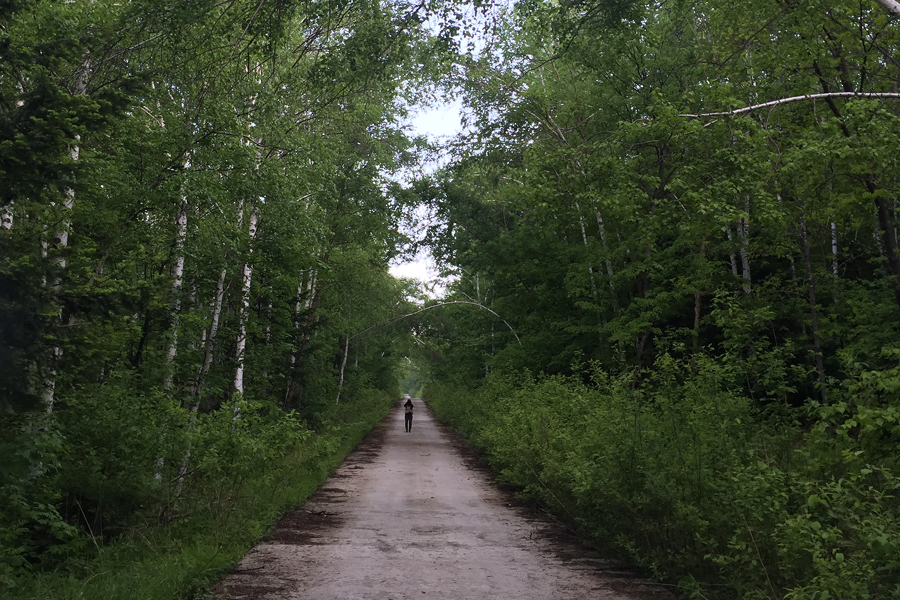
The forests of Boli County change markedly from season to season. On our brief initial trip in January 2015, winter visitors such as Common Redpoll, Eurasian Bullfinch, and Pallas’s Rosefinch were scraping out a living in the snowy, barren forests. In late summer bird waves are common, in springtime virtually non-existent. Late summer shows few birds in breeding mode but offers passage migrants. In springtime the songs of breeding birds resound.
Birds seen in one season may not be seen in another. In some cases, as with Hazel Grouse, it is easy to understand why. In other cases, the reason is less clear. Other birds, such as Red-flanked Bluetail, that one would expect in the region have yet to appear on any of our lists. Here are some of the birds we missed on our spring 2016 trip.
Hazel Grouse: On our summer 2015 expedition, Elaine and I noted this species on 10 days, both in the excellent habitat of Xidaquan and in the lower-quality forest in the hills south of Dawucun. We noted no Hazel Grouse in spring 2016. The grouse were breeding and had retired to the quiet recesses of the forest with their young.
Great Spotted Woodpecker: Common in much of China, noted just once by Elaine and me in summer 2015 and not at all in spring 2016. Its congener White-backed Woodpecker is common in the area.
Eurasian Three-toed Woodpecker: Scarce species noted by us once at Xidaquan in summer 2015. Missed in spring 2016.
Rufous-bellied Woodpecker, Japanese Pygmy Woodpecker: Rufous-bellied Woodpecker ssp. subrufinus is reported in eastern Heilongjiang, as is Japanese Pygmy Woodpecker. Neither has been found by us around Boli.
Black-naped Oriole: A species yet to be noted by us in Boli.
Azure Tit: This unmistakable tit has been reported around Lake Khanka, on the Sino-Russian border east of Boli County. We have yet to see the species in Boli.
Marsh Tit: Race brevirostris noted by us on 13 days in summer 2015, zero times in spring 2016.
Manchurian Bush Warbler, Baikal Bush Warbler, Chinese Bush Warbler: Yet to be noted by us in Boli.
Asian Stubtail: Noted on four days in summer 2015, zero times in spring 2016.
Manchurian Reed Warbler: We made a point to look for this bird, paying careful attention to the Black-browed Reed Warbler we were finding. No luck.
Yellow-browed Warbler: In spring 2016 we were expecting big counts of this species, having noted it on nine days in summer 2015. We noted it not once in spring 2016. It most likely does not breed in the area and was passing through the region in August and September 2015.
Arctic Warbler: Also apparently a passage migrant at Xidaquan. In spring 2016 we had but one record of a singing individual at Xidaquan. In summer 2015 we had two records.
Two-barred Warbler: Yet another apparent passage migrant. Noted on four days in summer 2015, zero times in spring 2016.
Red-flanked Bluetail: Surprise! We have yet to record this species in Boli County.
Eurasian Treecreeper: Noted by us four times in summer 2015, zero times in spring 2016.

FURTHER READING
“Birding Boli, Heilongjiang in May & June” is a two-part report. This is Part 1.
Part 1: Introduction and Discussion
Part 2: Daily Reports
shanghaibirding.com offers the world’s most complete coverage of birding Heilongjiang and Northeast China. Click any link:
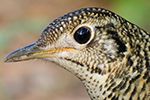
• Birding the Lesser Khingan Mountains: In the quasi-boreal forests of this range in central Heilongjiang, our family found East Asian specialties White’s Thrush and Siberian Thrush, enjoyed the song of Mugimaki Flycatcher, and glimpsed Northern Hawk-Cuckoo. We explored Wuying National Forest Park, gateway to the Lesser Khingans.
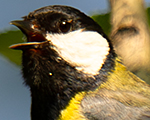
• Great Tit, New Eastern Record: We found Great Tit in Jiayin County, Heilongjiang, just south of the Sino-Russian border. On eBird our record of Parus major is the easternmost ever in China. The Great Tit was in the zone of contact between P. major and Japanese Tit P. cinereus minor, which we found nearby. The zone of contact is growing, and its boundaries remain unclear.
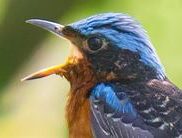
• Birds of the Remnant Manchurian Forest: Elaine Du and Craig Brelsford became the first birders to survey Wushun River National Forest Park, a vast forest reserve in Elaine’s home county of Boli in eastern Heilongjiang. We noted 91 species around Wushun, among them Ural Owl and local breeders Eastern Crowned Warbler, Radde’s Warbler, and White-throated Rock Thrush.
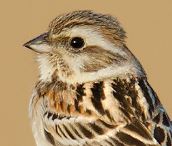
• Jankowski’s Bunting and Other Northeast China Species: On their first trip to Northeast China, Elaine Du and Craig Brelsford found Jankowski’s Bunting in Inner Mongolia and counts of up to 600 Siberian Crane in Jilin. Tumuji wetland yielded Red-crowned Crane and Oriental Stork as well as flocks of hundreds of geese, and at Zhalong Nature Reserve in Heilongjiang we found Swan Goose and White-naped Crane.
shanghaibirding.com also covers Sikhote-Alin Nature Reserve in the Russian Far East: Sikhote-Alin: A Place Unparalleled for Experiencing the Birds of East Asia
Featured image: Band-bellied Crake Zapornia paykullii, Boli, Heilongjiang, China. (Craig Brelsford)

Be notified every time we post. Send an
email with “Subscribe” as the subject to
info@shanghaibirding.com
Donate to Shanghai Birding!
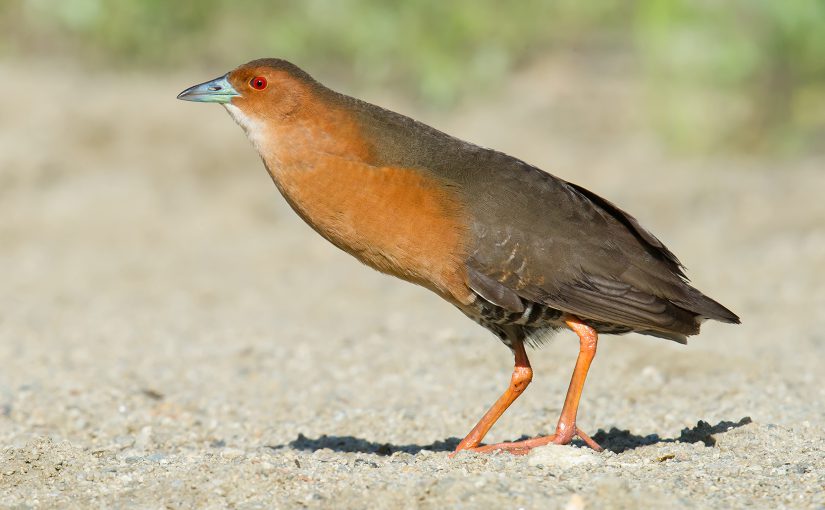
I was recently in Harbin and did a little birding however there was one, possibly two, bird(s) that had me stumped. I am expecting that you can easily identify them.
I am having trouble with the I have put in as Eurasian Siskin https://ebird.org/australia/checklist/S60807161. It was commonly feeding in Birch trees, sometimes with Redpolls – which were about the same size.
The other, again put in as Eurasian Siskin is in https://ebird.org/australia/checklist/S60832609. This was a small bird, about 2/3 the size of a house sparrow that was feeding on the ground by itself. It looked similar to the previous birds but I have my doubts that it is the same.
Sorry to trouble you. Almost all the species I saw in China were completely out of my comfort zone. Once away from Australia I found myself a complete beginner again.
Hello Lance and welcome to shanghaibirding.com. I looked at both checklists. Eurasian Siskin all the way.